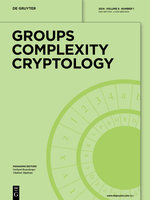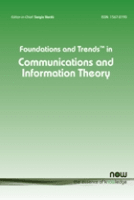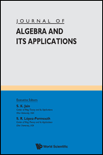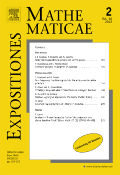
Advances in Mathematics of Communications
Scope & Guideline
Advancing Knowledge in Algebra, Number Theory, and Beyond
Introduction
Aims and Scopes
- Coding Theory:
The journal publishes research on various coding techniques including linear codes, BCH codes, MDS codes, and cyclic codes, emphasizing their properties, constructions, and applications in error correction and data transmission. - Cryptography:
A significant focus is placed on cryptographic methods and protocols, including public-key systems, hash functions, and post-quantum cryptography, reflecting the growing need for secure communication in the digital age. - Algebraic Structures:
Research on algebraic structures related to coding and cryptography is prevalent, covering topics such as group theory, finite fields, and polynomial functions, which are foundational for developing new coding and cryptographic techniques. - Algorithm Development:
The journal encourages contributions that advance algorithmic approaches for solving problems in coding theory and cryptography, including decoding algorithms, complexity analysis, and optimization techniques. - Interdisciplinary Applications:
There is a notable emphasis on the interdisciplinary applications of mathematical theories in real-world scenarios, particularly in computer science, information theory, and network communications.
Trending and Emerging
- Post-Quantum Cryptography:
With the advent of quantum computing, there is a significant increase in research focused on developing cryptographic systems that can withstand quantum attacks, making this a critical area of exploration. - Machine Learning Applications:
The integration of machine learning techniques in coding theory and cryptography is gaining momentum, with new methodologies being developed to enhance code design and cryptographic security. - Algebraic Geometry Codes:
There is a resurgence of interest in algebraic geometry codes, which leverage geometric properties for constructing error-correcting codes, reflecting their relevance in modern communication systems. - Network Coding:
Research on network coding has gained traction, particularly in optimizing data transmission in networks, leading to innovative solutions for efficient communication. - Secure Multi-Party Computation:
Emerging work in secure multi-party computation reflects the growing interest in privacy-preserving techniques that allow multiple parties to compute functions without revealing their inputs.
Declining or Waning
- Classical Coding Techniques:
While foundational coding techniques remain important, there has been a noticeable decline in research focusing solely on classical coding methods without incorporating newer approaches or hybrid systems. - Basic Cryptographic Protocols:
Research on basic cryptographic protocols appears to be waning, with a shift towards more complex and secure systems, particularly those addressing post-quantum security challenges. - Static Error-Correcting Codes:
The focus on static error-correcting codes without consideration of dynamic or adaptive systems has decreased, as newer research emphasizes the need for codes that can adapt to varying communication conditions. - Geometric Coding Approaches:
There has been a reduction in publications related to geometric coding methods, which traditionally focused on applications in specific communication channels, as researchers now explore broader and more generalized frameworks.
Similar Journals

Groups Complexity Cryptology
Connecting Minds in the Realm of Complexity and SecurityGroups Complexity Cryptology, published by EPISCIENCES, is an esteemed Open Access journal that has been contributing to the fields of Applied Mathematics, Computational Mathematics, Computational Theory, and Computer Networks and Communications since its inception in 2009. With its headquarters located in France, this journal serves as a crucial platform for disseminating innovative research and solutions in cryptology and related areas. As of 2023, it proudly holds Q4 rankings across several categories in Scopus, indicating its recognized, yet emerging position within the academic community. Additionally, it is indexed under various categories such as Applied Mathematics, where it ranks in the 24th percentile, showcasing its potential for growth and increased visibility among researchers. The journal adheres to an open-access model introduced in 2020, allowing for widespread accessibility and engagement with cutting-edge research. This enhances the journal's mission to foster academic communication and collaboration among researchers, professionals, and students interested in the complex interplay of groups, complexity, and cryptography.

TRANSACTIONS OF THE AMERICAN MATHEMATICAL SOCIETY
Championing Excellence in Mathematical ResearchTRANSACTIONS OF THE AMERICAN MATHEMATICAL SOCIETY, published by the American Mathematical Society, is a premier journal in the field of mathematics that has been contributing to the advancement of mathematical knowledge since 1900. With an ISSN of 0002-9947 and an E-ISSN of 1088-6850, this journal holds a prestigious position in the academic landscape, evidenced by its Q1 rankings in both Applied Mathematics and Miscellaneous Mathematics categories as of 2023. With a Scopus ranking of #97 in General Mathematics and a percentile standing of 75th, the journal is recognized for its rigorous peer-review process and the quality of the research it publishes. Though it does not currently offer open access options, it essentially serves as a vital resource for researchers, professionals, and students seeking critical insights and developments in mathematical theory and applications. The Transactions aim to publish high-quality research articles that foster the exchange and dissemination of ideas, supporting the growth of both theoretical and applied mathematics within the global scholarly community.

Foundations and Trends in Communications and Information Theory
Transforming Research into Real-World ApplicationsFoundations and Trends in Communications and Information Theory, published by NOW PUBLISHERS INC, is a prestigious journal that has established itself as a leading platform in the fields of communications and information theory since its inception in 2004. With an impressive duration of publication extending to 2024, this journal captures the latest advancements and methodologies in applied mathematics, as well as computer networks and communications, currently ranking in the Q1 category in both domains for 2023. The journal's commitment to high-quality, peer-reviewed content is reflected in its significant impact factors, including a rank of #29 out of 635 in applied mathematics and #70 out of 395 in computer networks and communications on Scopus. By offering an in-depth look at theoretical underpinnings and practical applications, Foundations and Trends in Communications and Information Theory serves as an invaluable resource for researchers, professionals, and students alike, fostering innovation and scientific discourse in these rapidly evolving fields.

Algebra And Discrete Mathematics
Advancing Mathematical Knowledge through Rigorous ResearchAlgebra And Discrete Mathematics, published by LUHANSK TARAS SHEVCHENKO NATIONAL UNIVERSITY, is a pivotal academic journal dedicated to exploring the realms of algebra and discrete mathematics. Since its inception in 2012, this journal has contributed significantly to the mathematical community, catering to researchers, professionals, and students interested in advancing their understanding of both classical and contemporary mathematical theories. With categories placed in Q4 in Algebra and Number Theory and Q3 in Discrete Mathematics and Combinatorics, and rankings that place it among various domains with percentiles reflecting its niche status, the journal offers a platform for innovative and high-quality research. While the journal is currently not open access, it maintains a robust academic presence, and its continuous publication until 2024 ensures a steady stream of scholarly discourse. Researchers and academics keen on disseminating their findings or keeping abreast of the latest developments in these mathematical fields will find valuable insights and diverse methodologies within its pages.

International Journal of Mathematics and Computer Science
Advancing the Frontiers of Mathematics and Computer ScienceThe International Journal of Mathematics and Computer Science (ISSN: 1814-0424, E-ISSN: 1814-0432), published by Lebanese University, serves as a vital platform for disseminating innovative research and advancements in the fields of mathematics and computer science. With a compelling range of topics including Algebra, Applied Mathematics, Computational Mathematics, and Statistical Analysis, this journal caters to a broad audience of researchers, professionals, and students. Spanning the years from 2017 to 2025, it has established a presence in several key quartiles, including Q3 rankings in Applied Mathematics and Computational Mathematics, and a Q4 ranking in Algebra and Number Theory. While currently not an open-access journal, it provides valuable insights through its rigorous peer-reviewed process, enhancing its relevance in both theoretical and applied domains. Furthermore, its presence in Scopus rankings reflects its commitment to quality, making it an essential resource for anyone looking to explore the intersection of mathematics and computer science.

International Journal of Computer Mathematics- Computer Systems Theory
Connecting Theory and Practice in Computer SystemsInternational Journal of Computer Mathematics - Computer Systems Theory, published by Taylor & Francis Ltd, is a vital resource in the fields of computational mathematics and computer systems theory. With an ISSN of 2379-9927 and E-ISSN 2379-9935, this journal has established a prominent presence in academia since its inception in 2016. It is categorized in the Q3 quartile for both Computational Mathematics and Computational Theory in 2023, reflecting its impact and contribution to the scholarly discourse within these domains. The journal’s Scopus rankings further emphasize its academic relevance, placing it in the 38th and 33rd percentiles in their respective categories. International Journal of Computer Mathematics aims to disseminate innovative research findings, methodologies, and theoretical advancements, making it an essential publication for researchers, professionals, and students looking to deepen their understanding of computational methods and applications. Although it currently does not offer open access, the journal continues to provide insightful contributions to the scientific community, fostering the evolution of computational sciences.

CANADIAN JOURNAL OF MATHEMATICS-JOURNAL CANADIEN DE MATHEMATIQUES
Fostering collaboration and innovation in mathematics.Canadian Journal of Mathematics - Journal Canadien de Mathématiques is a prestigious peer-reviewed journal published by Cambridge University Press, which aims to advance the field of mathematics through the dissemination of high-quality research articles. With its ISSN 0008-414X and E-ISSN 1496-4279, the journal plays a pivotal role in fostering mathematical research and collaboration. It has been recognized for its impactful contributions, currently holding a category quartile ranking of Q2 in Mathematics (miscellaneous) for 2023 and sits in the 66th percentile among its peers according to Scopus rankings. As the journal continues its convergence from its inception in 1994 through to 2024, it remains a vital resource for researchers, professionals, and students seeking to stay at the forefront of mathematical developments. The journal does not operate under an open access model, allowing for a curated collection of articles that adhere to rigorous academic standards.

DISCRETE MATHEMATICS
Unraveling the complexities of mathematical structures.DISCRETE MATHEMATICS, published by Elsevier, is a leading journal dedicated to the field of discrete mathematics and combinatorics, with a distinguished presence in the academic community since its inception in 1971. With an ISSN of 0012-365X and an E-ISSN of 1872-681X, this esteemed journal has firmly established itself within the Q1 category for Discrete Mathematics and Combinatorics, and Q2 for Theoretical Computer Science as per the 2023 metrics, underscoring its pivotal role in advancing research in these vital areas. DISCRETE MATHEMATICS is highly regarded, reflected in its Scopus rankings, where it stands at #44 out of 92 in its primary category, contributing significantly to the global discourse on complex mathematical theories and applications. Published from the Netherlands, the journal serves as a crucial resource for researchers, professionals, and students looking to stay informed about the latest innovations and methodologies in discrete mathematics. Though currently not an open-access journal, DISCRETE MATHEMATICS continues to foster a vibrant scholarly community through rigorous peer-reviewed research, promoting a deeper understanding of the mathematical structures that underpin both theoretical and applied science.

JOURNAL OF ALGEBRA AND ITS APPLICATIONS
Fostering Intellectual Growth in Algebra and BeyondJOURNAL OF ALGEBRA AND ITS APPLICATIONS, published by WORLD SCIENTIFIC PUBL CO PTE LTD, stands as a pivotal resource for scholars in the fields of Algebra and Applied Mathematics. With an ISSN of 0219-4988 and E-ISSN 1793-6829, this journal has been providing a forum for the dissemination of cutting-edge research since its inception in 2008, converging towards a forward-looking timeline extending to 2024. As of 2023, it has earned a commendable Q2 ranking in both Algebra and Number Theory, as well as Applied Mathematics, reflecting its solid impact within the mathematical community. With a Scopus rank of #49/119 in Algebra and Number Theory, and #420/635 in Applied Mathematics, the journal captures significant advancements and applications across various mathematical domains. While it does not operate under an open access model, its comprehensive articles and research outputs are crucial for fostering intellectual dialogue and innovation in academia. Researchers, professionals, and students alike will find this journal an indispensable asset for their scientific pursuits and explorations into the vast field of mathematics.

EXPOSITIONES MATHEMATICAE
Championing Excellence in Mathematical ScholarshipEXPOSITIONES MATHEMATICAE, published by Elsevier GmbH, stands as a significant journal in the realm of mathematics, catering primarily to researchers, professionals, and students. With an ISSN of 0723-0869 and an E-ISSN of 1878-0792, this journal has made its mark in the academic community, boasting a Q2 classification in the miscellaneous mathematics category for 2023, illustrating its prominence within its field. The journal addresses a diverse scope of mathematical topics, encouraging the publication of original research and innovative theories while maintaining rigorous academic standards. As it converges from 2004 to 2024, EXPOSITIONES MATHEMATICAE continues to be an essential resource for advancing mathematical knowledge and fostering scholarly communication, despite being a non-open-access publication. Its location in Munich, Germany further anchors it within a rich intellectual tradition, providing accessibility for the mathematical community worldwide.